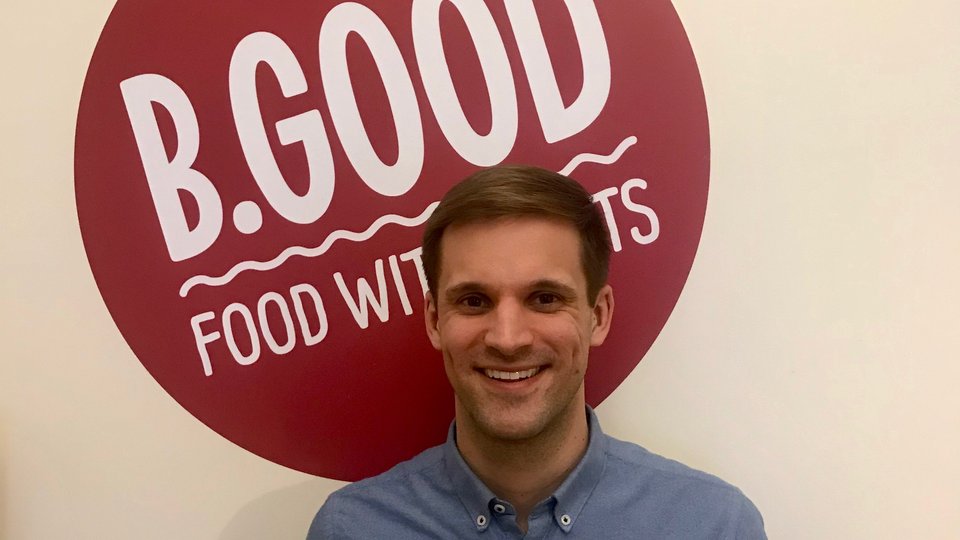Article
How transparency, technology help B.Good control supply chain
Joe Cloud, the director of Supply Chain at B.Good, weighs in on the importance of transparency.

January 29, 2019
Editor's note: Beating the Supply Chain Blues is an ongoing series that features advice and information from supply chain executives in the fastcasualindustry. Each installment will include a Q and A. If you are interested in being featured, email edtior@fastcasual.com
Transparency is one thing that B.Good just can't get enough of, which is why it is an important part of the chain's supply chain strategy, said Joe Cloud, director of Supply Chain at B.Good, a farm-to-table, fast casual restaurant chain with 61 locations across the U.S. and 74 worldwide. The former finance manager at Restaurant Brands International not only oversees the day-to-day supply chain operations and strategy at B.Good but also works to improve sustainability practices, often experimenting with new farming practices to inspire youth through education at B.Good's Hannah Farm in Boston.
He recently discussed with FastCasual why the word means so much to the chain and how using a variety of technology helps the chain meet its transparency goals.
Q. What types of technologies do you use to help manage the supply chain?
A. At this time, our primary focus is on ordering, inventory and vendor management software solutions. We recently switched to a new back-of-house technology solution, which has given us more holistic insight into the business and offers one centralized system to manage nearly everything that goes on in our 66 restaurants in the U.S. and Canada. Not only does this technology allow us to electronically integrate with our vendors (allowing our restaurant staff to focus more of their time on running their restaurants), but it also offers a robust inventory management solution, which has enabled us to drill into costs variances at the restaurant and product level and, ultimately, allows us to better manage costs. Beyond technology that aids cost management, we're constantly evaluating new solutions around safety and risk management, which are always top-of-mind in restaurant environments.
Q. How has customer expectations for transparency and traceability changed your processes?
A. Transparency is built into our business model at B.Good, so while we see heightened customer expectations around transparency, we're fortunate that it has been ingrained within us since the start. Since our founding, we've offered local boards within our restaurants that showcase the communities and partnerships that we're supporting and where our food comes from. That said, while we've always had a position on transparency, we have certainly started talking about it more now that a growing number of consumers are seeking this information.
Additionally, while we're in a good position and in many ways ahead of the curve, it's important we continue to build more transparency into our supply chain because our guests care where their food comes from and its part of our roots. For instance, we're currently testing digitizing our local boards, which would give consumers an even deeper level of information about the product journey throughout the supply chain.
Q. Food safety has become a huge issue in the industry; how are you working to ensure that your food offerings are as safe as possible?
A. There are two elements of food safety and risk mitigation; the restaurants and the supply chain. At the restaurant level, we have strict standards and procedures in place, and we also regularly conduct third-party audits to further safeguard ourselves. On the distribution side, we have a number of checks in place. At the supplier level, we're evaluating all partners before conducting business to make sure they're passing all safety audits and regulations. Additionally, we have great relationships with our distribution partners and are able to leverage their technology solutions to manage and divert any potential risk.
Q. What do you see as the most important aspect of a secure and solid supply chain?
A. Food safety and the ability to manage risk upfront are definitely most important, but the second piece of that is adaptability and being able to make changes very quickly. We're doing everything we can to prevent risks upstream, but in reality, there is a point at which something will enter our supply chain or restaurants. In these situations, it's critical to be quick to communicate, remove and replace. Beyond the importance of adaptability from a food safety standpoint, it's also enabled us to better meet customer preferences and trends, which are reflected in our menu and product offerings.
Q. Have you looked into using blockchain tech to enable traceability in your food supply chain? Why or why not?
A. We're continuously evaluating emerging technology and certainly think there's strong potential in blockchain – specifically as it relates to traceability. That said, as a farm-to-table chain, we work with many small farmers who are not yet equipped to leverage this technology solution, which requires a significant investment. At this time, our farmers and our products are our top priority. We're not willing to compromise relationships or the quality of our products in order to tap into national farmers solely because of their ability to implement the technology. In the future, if the technology works its way downstream to smaller, regional farmers, then we can certainly see it as a solution that could fit into our menu and business model.







